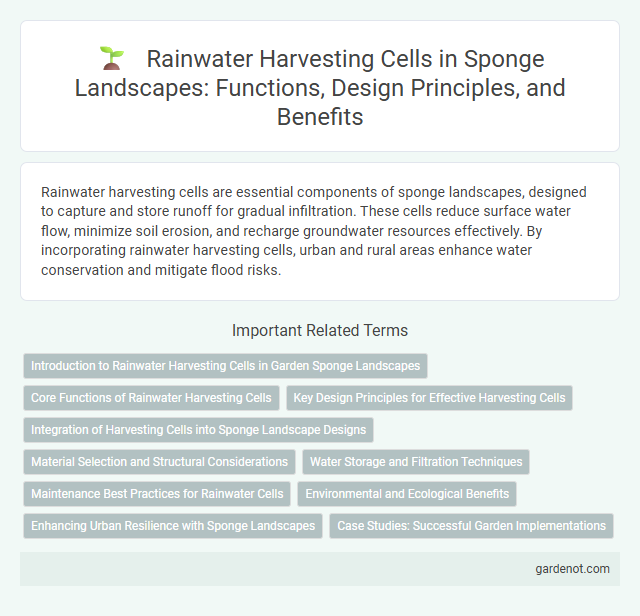Rainwater harvesting cells are essential components of sponge landscapes, designed to capture and store runoff for gradual infiltration. These cells reduce surface water flow, minimize soil erosion, and recharge groundwater resources effectively. By incorporating rainwater harvesting cells, urban and rural areas enhance water conservation and mitigate flood risks.
Introduction to Rainwater Harvesting Cells in Garden Sponge Landscapes
Rainwater harvesting cells in garden sponge landscapes serve as crucial structures designed to capture and infiltrate rainwater, enhancing groundwater recharge and reducing surface runoff. These cells typically consist of excavated pits filled with permeable materials like sand, gravel, and organic matter, promoting efficient water absorption directly into the soil profile. Implementing rainwater harvesting cells supports sustainable water management by improving soil moisture levels and mitigating urban flooding in sponge landscape designs.
Core Functions of Rainwater Harvesting Cells
Rainwater harvesting cells primarily function to capture and store rainwater, enhancing groundwater recharge and reducing surface runoff. They facilitate infiltration by directing collected water into the soil, promoting soil moisture retention and reducing erosion. These cells also support urban greenery by providing a sustainable water source for plants and mitigating urban flooding risks.
Key Design Principles for Effective Harvesting Cells
Rainwater harvesting cells should be designed with proper slope to ensure optimal water infiltration and minimize runoff. Incorporating layered soil media and organic matter enhances water retention and supports groundwater recharge. Selecting appropriate site locations with permeable soil and integrating vegetation cover improves the effectiveness and sustainability of harvesting cells.
Integration of Harvesting Cells into Sponge Landscape Designs
Rainwater harvesting cells are integrated into sponge landscape designs to enhance urban water management by capturing and storing runoff for reuse. These cells, designed with permeable materials and vegetation, promote groundwater recharge while reducing surface flooding. Effective integration optimizes water retention and supports sustainable landscaping in areas prone to water scarcity.
Material Selection and Structural Considerations
Selecting permeable materials like gravel, sand, and geotextiles enhances infiltration and filtration in rainwater harvesting cells, promoting efficient groundwater recharge. Structural considerations involve designing stable cell walls using reinforced concrete or compacted soil to prevent erosion and collapse under varying loads. Proper layering and maintenance ensure durability and optimal function in capturing and storing rainwater within sponge landscapes.
Water Storage and Filtration Techniques
Rainwater harvesting cells integrate advanced water storage solutions such as underground cisterns and permeable basins designed to maximize retention and minimize evaporation. Filtration techniques often involve multi-layered sediment traps, bio-filtration through vegetative media, and activated carbon filters to ensure high water quality. These combined methods optimize rainwater storage efficiency and enhance the purity of collected water for sustainable urban drainage systems.
Maintenance Best Practices for Rainwater Cells
Regular inspection and cleaning of rainwater harvesting cells prevent clogging and maintain optimal water absorption capacity. Removing debris, sediments, and vegetation ensures uninterrupted infiltration and prolongs the lifespan of the cell. Implementing scheduled maintenance checks improves overall performance and supports sustainable stormwater management within sponge landscapes.
Environmental and Ecological Benefits
Rainwater harvesting cells enhance groundwater recharge by capturing and storing rainwater, reducing urban runoff and soil erosion in sponge landscapes. These systems support local biodiversity by maintaining moisture levels in the soil, promoting healthy vegetation growth and habitat stability. Implementing rainwater harvesting cells mitigates flood risks and improves water quality by filtering pollutants before they enter natural waterways.
Enhancing Urban Resilience with Sponge Landscapes
Rainwater harvesting cells integrated within sponge landscapes significantly improve urban resilience by efficiently capturing and storing runoff during heavy rainfall events, thereby reducing flood risks. These cells facilitate groundwater recharge and support urban greenery, which helps mitigate heat island effects and promotes biodiversity. Implementing rainwater harvesting cells in city planning enhances water management strategies and sustains ecosystem services essential for resilient urban environments.
Case Studies: Successful Garden Implementations
Rainwater harvesting cells have demonstrated significant effectiveness in sponge landscape projects, improving water retention and reducing runoff. Case studies from regions like semi-arid Maharashtra, India, reveal increased soil moisture and enhanced plant growth in community gardens using these cells. Data from these implementations show up to 40% higher groundwater recharge rates and improved drought resilience in urban green spaces.
Rainwater harvesting cell Infographic

 gardenot.com
gardenot.com